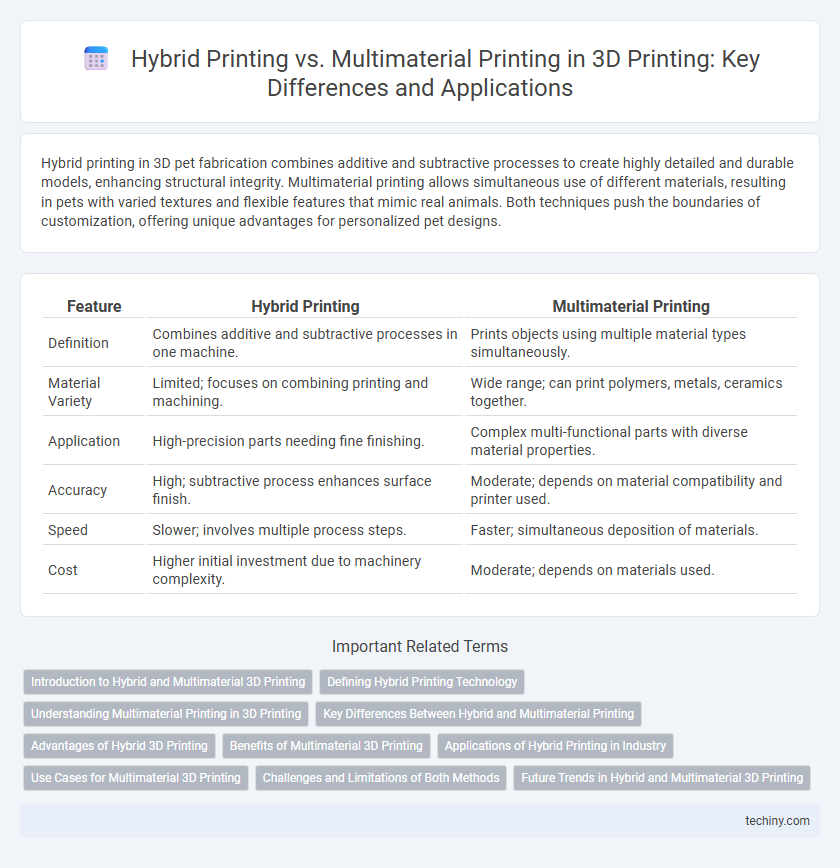Hybrid printing in 3D pet fabrication combines additive and subtractive processes to create highly detailed and durable models, enhancing structural integrity. Multimaterial printing allows simultaneous use of different materials, resulting in pets with varied textures and flexible features that mimic real animals. Both techniques push the boundaries of customization, offering unique advantages for personalized pet designs.
Table of Comparison
| Feature | Hybrid Printing | Multimaterial Printing |
|---|---|---|
| Definition | Combines additive and subtractive processes in one machine. | Prints objects using multiple material types simultaneously. |
| Material Variety | Limited; focuses on combining printing and machining. | Wide range; can print polymers, metals, ceramics together. |
| Application | High-precision parts needing fine finishing. | Complex multi-functional parts with diverse material properties. |
| Accuracy | High; subtractive process enhances surface finish. | Moderate; depends on material compatibility and printer used. |
| Speed | Slower; involves multiple process steps. | Faster; simultaneous deposition of materials. |
| Cost | Higher initial investment due to machinery complexity. | Moderate; depends on materials used. |
Introduction to Hybrid and Multimaterial 3D Printing
Hybrid 3D printing combines additive and subtractive manufacturing processes to enhance precision and surface finish, enabling complex geometries and high-quality finishes. Multimaterial 3D printing integrates different materials within a single build, allowing for varied mechanical properties, textures, and colors in a single object. Both technologies expand design possibilities by merging diverse fabrication techniques and materials for advanced functional and aesthetic applications.
Defining Hybrid Printing Technology
Hybrid printing technology combines additive manufacturing with subtractive processes, enabling the creation of complex parts with enhanced precision and surface finish. It integrates different printing methods such as fused deposition modeling (FDM) and stereolithography (SLA) within a single system, maximizing material diversity and structural integrity. This approach improves manufacturing efficiency by reducing post-processing steps and expanding design possibilities beyond traditional multimaterial printing.
Understanding Multimaterial Printing in 3D Printing
Multimaterial printing in 3D printing involves using two or more different materials simultaneously to create a single object with varied properties, such as flexibility, color, or strength. This technique enables complex designs with functional gradients and multi-functional features, offering enhanced customization compared to hybrid printing, which combines different printing technologies or processes. Key technologies for multimaterial printing include fused deposition modeling (FDM) with multiple extruders and inkjet-based material jetting, allowing precise deposition of distinct materials within one build.
Key Differences Between Hybrid and Multimaterial Printing
Hybrid printing combines additive manufacturing with subtractive processes, enabling the creation of precise, complex parts by layering materials and then machining them for finer details. Multimaterial printing involves extruding or depositing multiple materials simultaneously or sequentially within a single additive process, allowing for varied mechanical, thermal, or aesthetic properties in one build. The key difference lies in hybrid printing's integration of different manufacturing techniques versus multimaterial printing's focus on varying material compositions within a purely additive framework.
Advantages of Hybrid 3D Printing
Hybrid 3D printing offers significant advantages by combining additive and subtractive processes, resulting in higher precision and improved surface finishes compared to multimaterial printing alone. This method enables the production of complex geometries with enhanced mechanical properties through the integration of diverse materials and post-processing in a single workflow. Hybrid printing reduces production time and material waste, increasing efficiency and enabling more sophisticated, functional prototypes and end-use parts.
Benefits of Multimaterial 3D Printing
Multimaterial 3D printing allows the creation of objects with varying physical properties, such as flexibility, strength, and conductivity, within a single print. This technology enhances product functionality and complexity by integrating multiple materials like polymers, metals, and ceramics seamlessly. Manufacturers benefit from cost reduction and time efficiency by consolidating assembly processes and minimizing material waste.
Applications of Hybrid Printing in Industry
Hybrid printing in industry combines additive and subtractive manufacturing processes in a single setup, enabling the production of complex parts with enhanced precision and surface finish. This approach is widely applied in aerospace for lightweight components with intricate geometries, automotive for customized parts with embedded functionalities, and medical device manufacturing for patient-specific implants. Hybrid printing reduces production time and material waste while improving mechanical properties, making it ideal for industries demanding high-performance and customized solutions.
Use Cases for Multimaterial 3D Printing
Multimaterial 3D printing enables the production of complex objects incorporating diverse materials such as flexible polymers, rigid plastics, and conductive inks within a single build, making it ideal for creating functional prototypes, wearable devices, and multi-component assemblies. Industries like aerospace benefit from multimaterial printing by fabricating lightweight parts with embedded sensors, while healthcare leverages it for customized prosthetics combining soft and hard materials. This versatility surpasses hybrid printing, which typically combines multiple additive manufacturing methods but lacks the seamless material integration of multimaterial processes.
Challenges and Limitations of Both Methods
Hybrid printing faces challenges in synchronizing multiple printing technologies, leading to complex calibration and increased production time. Multimaterial printing struggles with inter-material adhesion and compatibility issues, resulting in structural weaknesses and limited material combinations. Both methods encounter scalability limitations and higher costs due to intricate hardware requirements and process control demands.
Future Trends in Hybrid and Multimaterial 3D Printing
Future trends in hybrid and multimaterial 3D printing emphasize seamless integration of additive and subtractive processes to enhance precision and surface finish. Advances in material science aim to expand the range of compatible polymers, metals, and ceramics, enabling multifunctional and gradient materials within a single print. AI-driven process optimization and real-time monitoring are poised to improve print reliability and accelerate the development of complex designs across aerospace, medical, and automotive industries.
Hybrid Printing vs Multimaterial Printing Infographic

 techiny.com
techiny.com